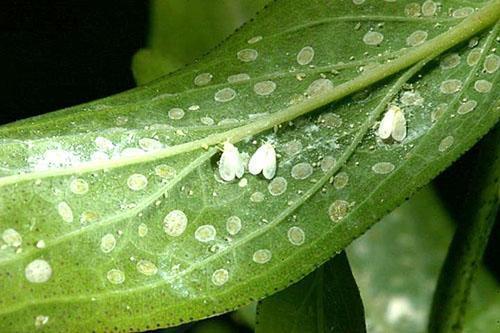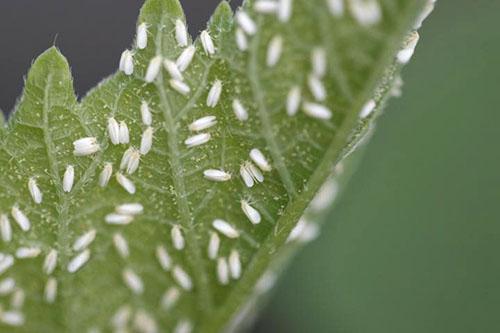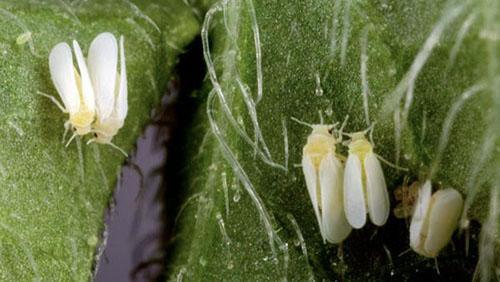Getting rid of whiteflies
 In this article, we will share experiences from foreign farmers and tell you how to identify and get rid of whiteflies. These small insects can be troublesome and pose a serious threat to plants.
In this article, we will share experiences from foreign farmers and tell you how to identify and get rid of whiteflies. These small insects can be troublesome and pose a serious threat to plants.
A bit of theory
Whiteflies, also known as aleurodids, are soft-bodied winged insects that are closely related to aphids and mealybugs. They live in most regions, however, they are so small that it is extremely problematic to detect them.
Flies can be no more than 2 mm in size, resemble a triangle from above and often accumulate on the lower part of the leaves. They are extremely active during the daytime, so they are easier to spot than some other nocturnal pests. Whiteflies are able to survive the winter, and in warmer regions they breed throughout the year.
One of the most common species is the tobacco whitefly, which is slightly smaller than its counterparts and is yellow in color. It is widespread in a wide variety of regions and affects a wide variety of plants.
You can often see whiteflies in late summer when the weather is warm, and also in greenhouses. This pest loves to suck liquid from heat-loving vegetables, such as tomatoes, eggplants, peppers, and okra. The insect also attacks sweet potatoes and cabbages.
How to spot whitefly on plants

Under the influence of whitefly, plants quickly weaken:
- they lose the ability to photosynthesize;
- leaves wither, turn pale or turn yellow, and further growth stops;
- honeydew is a sign that the pests have been feeding on this plant for several days;
- you may also notice a clump of ants that are attracted to this sweetish liquid.
Check the undersides of the leaves around the veins for honeydew and white insects, even when you can't see them at first glance. If you catch the moment when the pests feed, they will suddenly fly off the leaf in a whole swarm, so it will not be difficult to notice them.
Sometimes you will find eggs on the leaves. This is the beginning of a new generation. When they hatch, the small white oval-shaped larvae will immediately begin to suck on the plant sap, while they cannot move yet. For this reason, gardeners often don't notice the whitefly until it's too late. Adult females can produce up to 400 eggs, which hatch between one week and a month. They are attached to the leaf in circles, and the color ranges from pale yellow (recently laid) to brown (ready to hatch).
Ways to fight
 There is a rich arsenal of tips and traps you can use to control whitefly. But most importantly, the earlier you start, the better the result will be. In the morning and evening, as you stroll through the garden, check the undersides of the leaves and pay attention to the flocks of small flies that fly away as you approach.
There is a rich arsenal of tips and traps you can use to control whitefly. But most importantly, the earlier you start, the better the result will be. In the morning and evening, as you stroll through the garden, check the undersides of the leaves and pay attention to the flocks of small flies that fly away as you approach.
Always start by spraying water with a watering hose (not only for whiteflies, but also for aphids and many other insects). This will make the pests fly away. Then treat the leaves with insecticidal soap. Spray the substance completely on both sides.Spreading should be done at the end of the day when it is cool outside, as heat can cause an adverse reaction of plants to the insecticide. Repeat the procedure 2-3 times.
According to the stories of professional gardeners, a mixture of dishwashing detergent and water works well. The ideal proportion is 1 large syringe for 4.5 liters of liquid. It should also be sprayed in the morning and evening hours, when it is still cool outside. It should be noted that this composition is gentle. It is more suitable for preventing the development of a population of pests than for eliminating them.
If the solutions do not work and the number of harmful insects is not diminishing, you can use a handheld vacuum cleaner every few days to remove flies from the plants. It helps against both adults and larvae.
Preventive measures
 The presence of predatory insects on the site will prevent a sharp increase in the number of whiteflies. Ladybugs, spiders, lacewing, and dragonflies are a few beneficial insects. They will help keep the pest population under control. Try to create a dragonfly-friendly environment in your garden that is good for mosquitoes as well.
The presence of predatory insects on the site will prevent a sharp increase in the number of whiteflies. Ladybugs, spiders, lacewing, and dragonflies are a few beneficial insects. They will help keep the pest population under control. Try to create a dragonfly-friendly environment in your garden that is good for mosquitoes as well.
Whiteflies are resistant to chemical insecticides. Using them, you will destroy only beneficial insects, including natural predators and pollinators for the garden.
Install yellow plastic cards or wooden planks covered with Vaseline:
- around tomatoes;
- peppers;
- sweet potatoes;
- cabbage crops.
A 50/50 mixture of petroleum jelly and dishwashing detergent will be sticky enough to keep out flies. To whiteflies, yellow looks like a mass of fresh foliage. The insects get stuck in the "jelly" and die.
The whitefly is a very hardy and annoying insect. Therefore, the timely use of protective equipment plays a decisive role in the fight against it. Do not let the population grow, and you can destroy pests without any problems. If the moment is missed, then the tips in this article will definitely help you.
Whitefly preparations Teppeki, Voliam flaxi, Coragen are not very effective or effective !!!